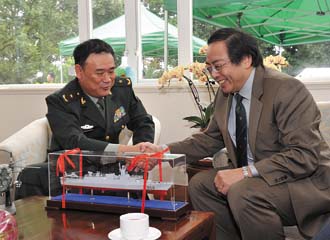China Looks to the Future With New Corvette
 |
Maj. Gen. Wang Junli, PLA (l), Hong Kong military garrison deputy commander, presents a model of China’s new 056 corvette to Hong Kong University Vice-Chancellor Lap-Chee Tsui. The corvette represents a new littoral capability for the PLA Navy. |
China has departed from tradition with a new naval ship design that may be the vanguard of an entirely new class of littoral warships. These corvette-type vessels feature modernized systems that offer China unprecedented flexibility in a range of sea missions.
This new corvette design shows the Chinese commitment for increased People’s Liberation Army Navy (PLAN) future littoral water goals, as does the littoral combat ship for the U.S. Navy. Only two new surface ships have been serial-built in multiple Chinese shipyards recently—the 053 Jiangkai series frigates and the 022 Houbei series missile catamarans. The corvette may be the third, and it promises enhanced capabilities that are offered only piecemeal on other ships.
Rumors have been circulating that the next mass-production warship would be a corvette, and the first picture of what it would look like appeared in a Hong Kong University press release with a photograph of a Type 056 model in November 2010. Because the deputy commander of the Hong Kong military garrison, Maj. Gen. Wang Junli, PLA, presented it to Hong Kong University Vice-Chancellor Lap-Chee Tsui, some observers have suggested that the 056 would replace the six Houjian fast attack craft (FAC) based in Hong Kong since 1997. Chinese sources claim that the 056 is intended to replace old Houxin attack craft and early 053S series frigates.
PLAN Jiangkai II modern frigates weigh 3,400 tons without combat load and crew (light load) and 3,800 tons with fuel, ammunition, stores and crew (full load). However, the earlier 053S series frigates in the 1970s weighed 1,400 to 1,700 tons. Although the 056 tonnage is not confirmed, the size in the illustrations could be approximate to that. The ship certainly is not similar to the 528-ton Houjian or the 478-ton Houxin attack craft range. In fact, a tonnage estimate of between 1,000 and 1,800 tons shows the lack of information. The 056 seems intended to replace the decommissioned Jiangnan frigates and the 20 obsolete Jianghu I and II series frigates remaining in the East and South Sea Fleets. The comparison of hull lengths seems to back up this conclusion, with the attack craft having hull lengths of 63 and 65 meters compared to Jianghu I length of 103 meters and 056 estimated length of 90 meters.
Topside are many common sensors and weapons, with the exception of a new-generation surface-to-air missile (SAM) and the modern automatic Russian AK-176 gun mount. Going from fore to aft, a medium-size bow sonar dome likely is the SO7H or another similar medium frequency sonar along with associated twin six-barrel antisubmarine warfare (ASW) launchers on the forecastle. The ASW rockets are the Chinese Type 87 with six 252-millimeter barrels. They are modified by China from the five-barrel Russian RBU-1200 ASW launcher. China added a sixth barrel and increased the range from 1,200 meters to 3,200 meters. These are adequate for littoral small vessel self-protection.
Further aft on the bow is the Chinese copy of the Russian AK-176 76-millimeter dual-purpose gun. The 056 is the first small PLAN warship to have this new-generation main battery—the much larger 20,000-ton landing platform dock, or LPD, Type 071 contained the first one three years ago. The AK-176 fires 120 rounds per minute (RPM) with a maximum range of 15 kilometers compared to the Jianghu 100-millimeter gun with a range of more than 20 kilometers but a firing rate of only 15 RPM. The old Russian 100-millimeter gun fired 30 to 50 RPM, but it was downgraded for export to China.
Except for maximum range, the AK-176 has many advantages over the older 100-millimeter gun. The older gun needed a crew of five to six men and weighed 49 tons, compared to the AK-176’s two-man crew and gun mount weight of only 16 tons with seven times the RPM rate. Even though the Jianghu had guns fore and aft, the 056’s single AK-176 puts out four times as many rounds as two 100-millimeter guns.
Aft of the bridge is an I/J band, Type 347G gun fire-control radar. This compares to an optical 100-millimeter fire control system (FCS) on the Jianghu. The enclosed mast aft of the radar has what appear to be two electronic countermeasure (ECM) globes on each side and one on the forward side. They are not found on the Jianghu. These ECM units would be passive intercept and active jamming antennas. Farther up is a standard RACAL RM 1290 I-band navigation radar, and above that is a common Type 360 E/F band Seagull surface search radar. There appear to be antiaircraft small-caliber gun mounts on both sides, possibly a 30-millimeter Type 730 Gatling gun close-in weapon system. Just forward of the stack are two square surface-to-surface missile (SSM) launchers with two cells each, which probably contain the latest YJ-83 SSMs. These are far more capable than the four Mach 0.8, 40-kilometer range SY-1 SSMs equipping the Jianghus, which were copies of early Soviet Styx or Chinese Silkworm missiles. The YJ-83 has a speed of Mach 1.6 with a range of 200 kilometers.
Aft of the stack are two radomes that might contain satellite navigation or communication antennas. The next two systems aft on the O-2 deck are both new. Because the aft system is a new 24-cell FL-3000N SAM launcher, one would expect the pedestal forward to be the associated missile fire control director. However, the FL-3000N missile has passive infrared (IR) and radio frequency, or RF, onboard sensors, so it does not require any topside fire control director. The FL-3000N has an FCS that can control two launchers on larger ships, but the 056’s systems more likely would be controlled by the existing 056 weapon FCS. The designation of this FCS is unknown because the PLAN has used new FCS designations on new vessels.
The 2-meter-long missile features two IR sensor horns protruding externally on the nose of the missile. Introduced at the 2008 Zhuhai air show, the FL-3000 is intended for land-based, aircraft and naval platforms. This weapon promises to be on next-generation platforms and backfitted to replace earlier-generation anti-air missiles. Internet Web pictures show the FL-3000N being installed on the ex-Varyag carrier, and some reports state that it is to be installed on large auxiliary vessels. Poor-resolution illustrations make it difficult to identify two cylinders on the ends of a horizontal mast, although they look like HN-900 datalinks. Tactical datalinks are mandatory on this vessel for coordinated tactics.
A small, flat antenna on top appears to be a helicopter landing radar. A flight deck carrying the general-purpose Z-9 helicopter would be a great advantage with ASW and other multipurpose mission capabilities. In the Aden Gulf deployment operations, the PLAN has raved about the versatility of the 054A helicopters in all missions.
Illustrations of the stern show an object under the flight deck that would be where a variable-depth sonar (VDS) could be located, but it is very unlikely that a littoral ship would carry a deep-water sensor like that. China has not installed a VDS on a warship since the two Luhu-class guided missile destroyers (DDGs) in 1991.
The 056 has a pair of 8-meter whip antennas and a 6-meter one aft on the stack, a pair of 7-meter whips aft on the O-1 deck, and two 5-meter whips on the bridge. Chinese-language naval journals are the initial source of 056 illustrations, but they vary in systems shown. Modern Ships 2011 issue 01A shows bow ASW launchers, nothing on the deck above the bridge and two radomes aft of the stack. Naval and Merchant Ships 2011 issue 1 shows no forward ASW launchers or aft radomes, but it does show a box-shaped system above the bridge that looks similar to an E-O director.
Below-decks systems are expected to be standard frigate systems but with more automatic control panels such as those used for power distribution. Chinese vessels smaller than DDGs have been using 16PA6V-280 sequential turbocharging (STC) series of diesel engines that have been license-built by Shanxi Diesel for two decades. The Shanxi plant has a new, more powerful diesel available that is a probable choice. It is the MAN 20V28/33D STC that generates 9,000 kilowatts.
The crew size for the 056 should be less than expected for a 1,500-ton warship. The Huafeng missile boats being replaced by the 022 Houbei had crews of 26, compared to the 022’s crew of only 12 with similar tonnage. The 054A frigates of 3,400 tons have a crew of only 180 compared to the 1,700-ton Jianghu with a crew of 195. These figures reflect the increased automation on the PLAN’s latest construction. Instead of a crew of 190 on a ship of this size, the 056 may have a crew as small as 110 men, reflecting increased automation of systems resulting in reduced manning. The 054A had reduced weapon and sensor crew maintenance requirements in part because it had a fault isolation software that automatically sent repair part requests to support ships or ashore support. This maintenance feature performed well on Aden Gulf extended deployments. With its sophisticated weapons, the 056 almost certainly has roll stabilizers to aid FCS.
These vessels probably will operate in the South Sea Fleet, based mainly out of Yulin, Hainan. This is optimum for South China Sea operations that deal with disputed island claims in the Spratly and Paracel islands. China’s paramilitary vessels are able to police only foreign fishing boats or other craft in China’s 200-mile exclusive economic zone claims if unopposed. The Luda destroyers or 054A frigates are needed for other blue-water missions. The 056 class is ideal for Indian Ocean operations in which China confronts the Indian Navy in waters India considers its own. The last years have shown that the sea lines of communication to oil-rich African and Middle Eastern sources are based out of Hainan. The East Sea Fleet will find the 056 a useful addition around Taiwan or in contested Japanese Diaoyu Island confrontation operations as well as in denial of offshore waters to U.S. submarines and oceanographic surveillance vessels. Many of China’s old frigates based in Dinghai on Zhoushan Island also need modern replacements.
When the first 056 corvettes are commissioned in late 2012, some of the ambiguities will become clarified. These include whether the 056 does have a VDS or towed array under the helicopter deck, the midship AA gun type, the identity of the antennas forward of the FL-1000 SAM, and the exact dimensions and tonnage. The 056 is expected to be a large series production program from several shipyards, as is the Hubei Type 022.
James C. Bussert is the co-author of the book People’s Liberation Army Navy (PLAN) Combat Systems Technology 1949-2010 with Naval War College Professor Bruce Elleman, to be published by the Naval Institute Press in July 2011. The opinions expressed in this article do not necessarily reflect the views of the U.S. Defense Department or the U.S. Navy.




Comments